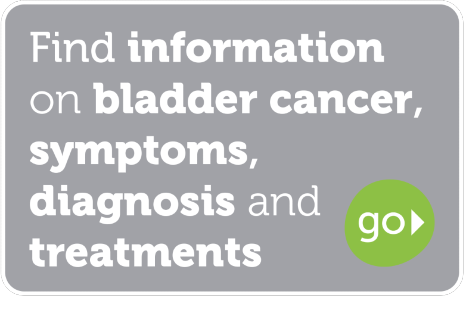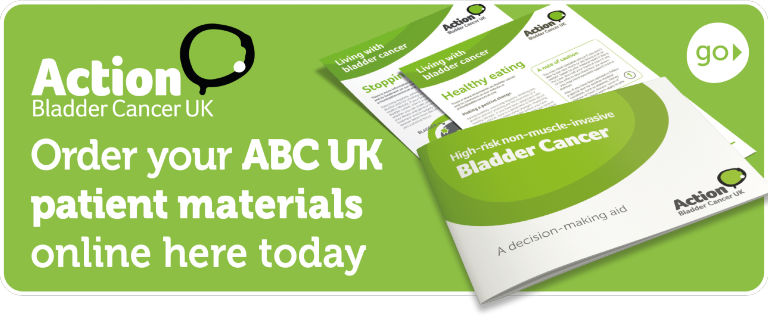Chemotherapy
Chemotherapy is drug treatment given to treat cancers. It may be given in addition to other treatments such as radiotherapy, before and/or after an operation, or on its own
There are two types of chemotherapy in bladder cancer treatment:
- Intravesical chemotherapy
- Systemic chemotherapy
Intravesical chemotherapy
Intravesical chemotherapy is drug-treatment given directly into the bladder usually through a catheter put into the bladder through the urethra. This treatment is usually given to patients who have certain types of non-muscle invasive bladder cancer, where there has been no spread into the muscle of the bladder wall. (see section on intravesical treatment). This treatment is usually arranged by the urology team.
Systemic chemotherapy
Systemic chemotherapy is drug treatment given via a drip into the veins. An oncologist will always work with your urologist to decide whether chemotherapy is needed and which chemotherapy will be the best for you.
Systemic chemotherapy can be given in a number of different situations in bladder cancer:
-
Neo-adjuvant
chemotherapy
Neo-adjuvant chemotherapy is given before a cystectomy (operation to remove the bladder) or before a radical (potentially curative) course of radiotherapy to improve the results of the radiotherapy or surgery.
Usually three cycles of chemotherapy are given (see below) and then you may have another telescope test (rigid cystoscopy) and CT /MRI scan to assess the response in the bladder to chemotherapy. Not all patients who are due to have either radical cystectomy or radical radiotherapy will be suitable for neoadjuvant chemotherapy. It depends on a number of factors such as how well your kidneys work, any other medical problems and the type of the bladder cancer
-
Down-staging
chemotherapy
If the bladder cancer has spread beyond the bladder into the surrounding tissues or to the lymph glands near to the bladder on the CT/MRI scans, but there is no spread elsewhere in the body you may be offered chemotherapy to downstage the cancer and see if either surgery or radiotherapy may then be possible. Three to six cycles of chemotherapy are usually given, with a CT/MRI scan done after three cycles to assess response to the chemotherapy.
-
Palliative
chemotherapy
Palliative chemotherapy is given when there is evidence on a CT/MRI scan of spread of the cancer beyond the bladder itself outside of the pelvis into other organs such as the lymph glands in the chest or abdomen, or into the lungs, or liver. Chemotherapy is usually given to improve quality of life and to help with any symptoms from the bladder cancer, and also to improve prognosis. Bladder cancer tends to be very sensitive to chemotherapy with a response rate of 60%. This means that 6 in 10 patients will feel better, or their scans will improve with chemotherapy but the chemotherapy is very unlikely to be a cure. The majority of patients will relapse at some point in the future and the point at which this may happen is different for each patient. Your oncologist will discuss this with you and will discuss what the aims of treatment are.
Sometimes the same type of chemotherapy can be used again if the cancer comes back, or a different type of chemotherapy may be considered.
HOW IS CHEMOTHERAPY GIVEN?
Most chemotherapy is given as an out-patient in an oncology unit. The nurses are specially trained in talking to you about chemotherapy and in giving the treatment.
Before you start your treatment you will need to have a blood test and be seen by a doctor or nurse. Sometimes this will be on the same day as your treatment, or some centres have a two appointment system - a pre-chemotherapy assessment on one day and chemotherapy delivery on a different day.
The nurse will then insert a fine plastic tube (cannula) into a vein in your arm. It may feel a little uncomfortable whilst it is being inserted. Sometimes, chemotherapy is given through a vein in the crook of the arm (PICC line) or through a fine plastic tube inserted under the skin into a long vein near the collar bone. This is called a central line.
Before the chemotherapy is given, you will be given an anti-sickness drug which may be given though the cannula or as a tablet. If you are having outpatient treatment, you can go home after the chemotherapy. The cannula is removed before you go home, unless you have a PICC or central line. If you have either a PICC or central line, you will be taught how to look after it whilst at home and how to shower etc with it in place.
You will also be given a supply of anti-sickness medication to take home with you. It is important to take these regularly to avoid the risk of being sick. If you find that you are feeling sick, have a temperature, sore throat, diarrhoea or any other side effects from the treatment, it is important that you seek medical advice. You will be given the contact telephone numbers of members of the chemotherapy team to contact, and it is important that you seek advice even if you feel unwell in the middle of the night.
CHEMOTHERAPY REGIMES
Three Week Cycle - Gemcitabine and cisplatin chemotherapy (gem-cis)
This is a combination of two drugs. They can be given in a number of different ways and your doctor or nurse will explain how you will have your treatment and give you written information. Usually you will have both the drugs, gemcitabine and cisplatin, on day 1 of treatment. A second dose of gemcitabine is then given one week later on day 8. Then you have a rest period of two weeks with no chemotherapy. This three week period is called a cycle of treatment. Usually three to six cycles of chemotherapy are given.
Gemcitabine is a colourless infusion which is given over about 30 minutes.
Cisplatin is a colourless infusion which is given over 1-4 hours. Cisplatin is removed from the body by the kidneys. This means that before it is given, you will be given extra infusions of fluid through the cannula into your vein to make sure that you are passing urine well and to reduce the risk of any kidney damage.
Four Week Cycle
Sometimes gem-cis may be given over a 28 day period with the gemcitabine given on day 1 together with cisplatin, and then gemcitabine on its own on day 8 and day 15. You then have two weeks off treatment. This four week period is called a cycle.
Your doctor will explain whether you will be having chemotherapy over the three or the four week cycle of treatment.
2. Gemcitabine and carboplatin (gem carbo)
Gem carbo is usually given as an outpatient. You will need a blood test before starting chemotherapy either on the same day or a few days before hand. You will also have blood tests to look at how well your kidneys are working and may need an additional test called an isotope GFR which is done in the nuclear medicine department.
On the first day of your treatment you will have both the gemcitabine and the carboplatin. Gemcitabine is a colourless infusion which is given over about 30 minutes. Carboplatin is a colourless fluid given as an infusion lasting for an hour.
You will have another infusion of the gemcitabine only on day 8. You then have two rest weeks without any chemotherapy. These three weeks together make up one cycle of treatment. Usually three to six cycles of chemotherapy are given.
3. MVAC Chemotherapy regime
This is a four drug regime using methotrexate, vinblastine, doxorubicin and cisplatin. MVAC treatment may involve an overnight stay in hospital or be given as a day patient.
- Methotrexate is a yellow fluid given as an injection into your cannula.
- Vinblastine is a colourless fluid given as a short infusion
- Doxorubicin is a red fluid given as an injection into the cannula
- Cisplatin is a colourless fluid given as an infusion.
Before the cisplatin you will be given bags of fluid through a drip to keep your kidneys working well. This may mean you need to stay in hospital overnight.
MVAC chemotherapy can be given in a number of different ways and your doctor will explain this to you. One schedule is described below but you should ask your doctor which schedule you will receive.
On day 1 and 2 of chemotherapy, you will be given each of the four chemotherapy drugs. You will also be given extra intravenous fluid as a drip and you may be given extra tablets called folinic acid to reduce some of the possible treatment effects with methotrexate.
On day 15 and 22 you will be given further methotrexate and vinblastine chemotherapy and then have one week off without any chemotherapy. This is called a cycle of treatment and lasts for four weeks. Usually 3 to 6 cycles of treatment are given.
Sometimes a regimen called accelerated or dose-dense MVAC is given. This uses the same four drugs as described above but the treatment is given in cycles that last for two weeks rather than four weeks. The treatment is given on the first two days of each 14 day cycle and special injections called GCSF are given for about 5 days to reduce the risk of lowering the white blood cell count (neutropenia). These injections are given once a day either by the patient, a carer or district nurse. The injections are given at home and may feel a little uncomfortable but do not usually hurt.
4. Second-line chemotherapy
Other chemotherapy regimes can be used as second line treatment.
This is when the first type of chemotherapy regime has stopped working well but the doctor feels that you will still benefit from another type of chemotherapy. Your doctor will give you more detailed information on these drugs if you need to be prescribed them.
There may also be the opportunity to be involved in a clinical trial at any point in your chemotherapy. Usually a new treatment will be being tested to see if it is any better than the standard treatment but your doctor will give you a detailed information sheet on any trial for which you might be suitable and you will have time to think about whether you want to participate.
EFFECTS OF CHEMOTHERAPY TREATMENT
Every person can have a different reaction to chemotherapy. Some people have very few treatment effects while others may experience more. The side effects listed below are the more common effects but will not affect everyone. Usually medication can be given to reduce the risk of treatment effects and to treat any effects you experience.
The list below compares some of the common treatment effects by chemotherapy regime:
|
Treatment Effect by Regime |
Gem Cis |
Gem Carbo |
MVAC |
|
Lowered resistance to infection |
✔ |
✔ |
✔ |
|
Bruising or bleeding |
✔ |
✔ |
✔ |
|
Anaemia |
✔ |
✔ |
✔ |
|
Feeling or being sick |
✔ |
✔ |
✔ |
|
Kidney damage |
✔ |
❌ |
✔ |
|
Loss of appetite |
✔ |
✔ |
✔ |
|
Rash and skin changes |
✔ |
✔ |
✔ |
|
Flu-like symptoms |
✔ |
✔ |
✔ |
|
Fluid retention |
✔ |
✔ |
✔ |
|
Numbness or tingling in the hands or feet |
✔ |
✔ |
✔ |
|
Hearing changes |
✔ |
❌ |
✔ |
|
Diarrhoea |
✔ |
✔ |
✔ |
|
Temporary changes in liver blood tests |
✔ |
✔ |
✔ |
|
Sore mouth and mouth ulcers |
❌ |
❌ |
✔ |
|
Sore mouth and taste changes |
✔ |
✔ |
✔ |
|
Hair loss |
✔ |
✔ |
✔ |
|
Lung changes |
✔ |
✔ |
✔ |
|
Allergic reaction |
✔ |
✔ |
✔ |
|
Chemotherapy can damage a foetus |
✔ |
✔ |
✔ |
|
Loss of periods in women |
✔ |
✔ |
✔ |
|
Discoloured urine |
❌ |
❌ |
✔ |
|
Skin changes |
❌ |
❌ |
✔ |
Lowered resistance to infection
This is called neutropenia - where the body's ability to fight infections can be affected by reducing the number of white blood cells in circulation. The typical time for this to happen is 7-10 days after the chemotherapy. The number of white blood cells usually returns to normal before the next cycle is due.
It is extremely important that you contact your doctor or go to Casualty
straight away if you suddenly feel unwell, even if your temperature is normal
or your temperature goes above 38°C on one occasion or > 37.8 on two
occasions.
If your blood count does not recover in time for the next cycle, your treatment may be delayed, or the dose adjusted. Sometimes injections to boost the white cell count may be given after chemotherapy (GCSF) to reduce the risk of neutropenia. Some medicines can interfere with chemotherapy so please tell your doctor about all medicines you are taking, whether these are prescribed by your family doctor or bought over the counter.
Your ability to become pregnant or father a child may be affected by the chemotherapy and it is important to discuss this with your doctor before you start chemotherapy.
SIDE EFFECTS
These vary from person to person, some are listed below:
|
Bruising or bleeding
|
If you have a lot of bruising, nose bleeds, blood in the urine or bowel motions or rashes on the skin, you should tell your doctor. |
|
Anaemia
|
Anaemia can make you short of breath or more tired and you may need a blood transfusion. |
|
Feeling or being sick |
Extra anti-sickness medications can be given and it is important not to become dehydrated. |
|
Kidney damage
|
Cisplatin can cause kidney damage and this is why extra fluid is given as a drip before cisplatin is given. Your blood tests are monitored carefully before cisplatin is given. |
|
Loss of appetite
|
Loss of appetite is common for a few days after chemotherapy and you may find a metallic taste in your mouth. |
|
Rash and skin changes |
Mention this to your doctor. |
|
Flu-like symptoms |
Very occasionally gemcitabine can cause a flu-like illness with joint aching, muscle pains and headaches. You should let your doctor know straight away. |
|
Fluid retention |
You may have ankle swelling or breathlessness. |
|
Numbness or tingling in the hands or feet |
Mention this to your doctor. |
|
Hearing changes |
Buzzing in the ears (tinnitus) or loss of high-pitched sounds |
|
Diarrhoea |
Mention this to your doctor. |
|
Temporary changes in liver blood tests |
Your doctor will discuss this fully with you following test results. |
|
Sore mouth and mouth ulcers |
Mention this to your doctor. |
|
Sore mouth and taste changes |
Your mouth may become sore 2-3 days after treatment. This usually gets better before the next treatment is due and you can have mouthwashes and medicine to help. |
|
Hair loss |
This is usually temporary. It can take several months for hair to grow back and it may be a different colour or texture than before chemotherapy. |
|
Lung changes |
Rarely gemcitabine can cause some narrowing of the airways which can make you feel breathless. |
|
Allergic reaction
|
Some people may have an allergic reaction to the chemotherapy drugs. Signs of an allergic reaction include skin rashes and itching, a high temperature, shivering, redness of the face, dizziness, headache, breathlessness, palpitations. |
|
Chemotherapy can damage a foetus
|
It is very
important that you use extra methods of contraception (barrier methods such
as condoms) whilst you are having chemotherapy as chemotherapy can damage
both eggs and sperm. |
|
Loss of periods in women |
Some women may find their periods become irregular and may eventually
stop. In younger women this may be temporary but in women closer to their
menopause it may be permanent. This can result in menopausal symptoms such as
flushes and vaginal dryness. |
|
Watery eyes |
Eyes may become watery and sensitive to sunlight. You may get eye pain or blurred vision although this is unusual. You may receive eye drops to help. |
|
Discoloured urine
|
Your urine may become a pink/red colour for up to a day after the treatment. This is harmless. |
|
Skin changes |
Your skin may be more sensitive to sunlight during the treatment and for several months afterwards. You should use a high sun protection factor when out in the sun and cover up and also wear a hat. |
How we help you
Latest News / Events
Understanding Bladder Cancer: Nurses' Education Event: 05 September 2025 11/04/2025
BOOKING HAS NOW OPENED for the annual major ABC UK Nurses' Education Day. Friday 5 September in Birmingham Register for your place here: Understanding Bladder Cancer and the Latest Developments Tickets, Fri 5 Sep 2025 at 09:00 | Eventbrite Full programme ...











